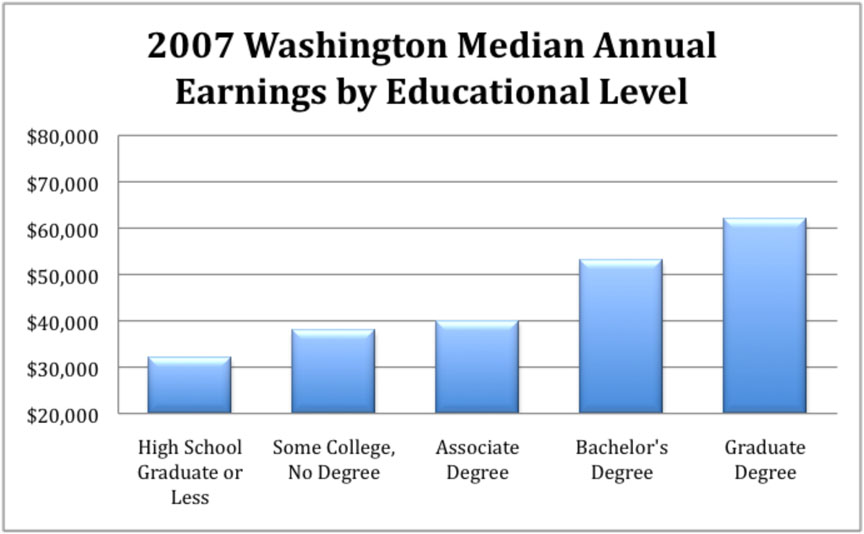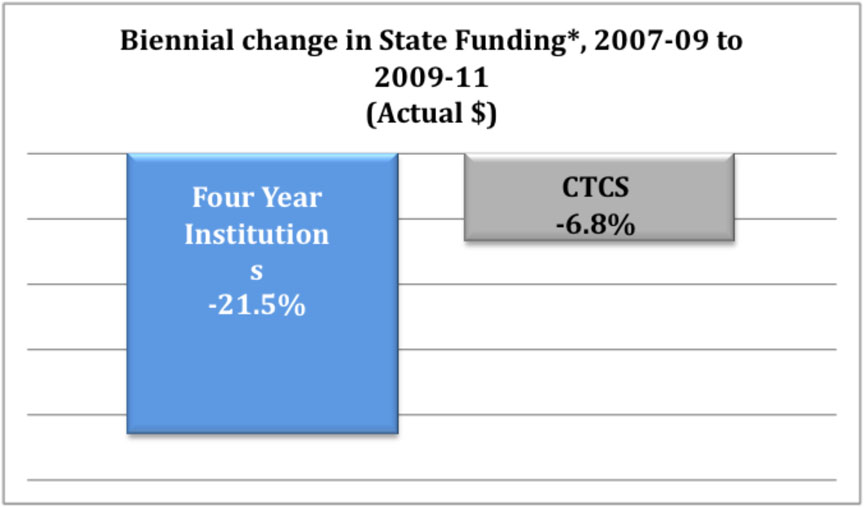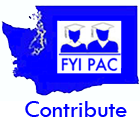What We Have Here is a Failure to Communicate

Here at the blog, our political education has come fast and furious. We still have a lot to learn, but there are two things we know for sure:
1. Stuff that is pure bullshit if it’s said enough in enough of the right places takes on the obduracy of sacred writ, and becomes very hard to challenge, no matter how dumb it might be.
2. Budget problems are really political problems.
In category 1 we have the widening divide between Washington’s public universities and its community colleges. A brief glance at the facts makes it clear that this state’s government places far more value on two-year higher education than it does on four-year higher ed. Washington ranks in the top five in community college participation rates and in the bottom five in four-year college participation rates. Washington is now first in the nation in the percentage of its higher education budget that is devoted to community and technical colleges. In the last twenty years, Washington has invested four times more in two-year colleges than in four-year colleges.
When we go trolling among legislators and their staff looking for explanations for this disparity, we inevitably encounter a series of myths:
Myth # 1: Only community college students get, need, or want jobs. In the 2010 supplemental state budget, the universities were once again cut more than the community colleges. This was done in the name of “Workforce Training.” The governor, legislators, business leaders, and staff from the State Board for Community and Technical Colleges all told us that the best way to turn the economy around is by training people for the sorts of lower middle class jobs that they would never consider for themselves or their children. Listen to the “workforce training” rhetoric for too long and you come away thinking that only people with Associates degrees get jobs and that those who get four-year degrees are only looking for navel-gazing self-fulfillment, with no intention or probability of ever joining the workforce.
But the facts, of course, are that people with 4-year degrees stand about a four times better chance of getting a job—a better job that pays more:
“Workforce training” might be better described as “policy enforcement of class barriers within the workforce.”
Myth # 2: Community and Technical Colleges are a more efficient, better bang for the buck. This is probably the most sacred of the CTC sacred cows. The reasoning is that since the community colleges are running faculty sweatshops, with mostly part-time, badly paid, no-benefits instructors, they must be generating education on the cheap. But in fact, administrative costs at the community colleges are higher than they are at the state universities and the gap between university-level instruction costs and community college instruction costs is rapidly shrinking. For every full time student who enrolls for the 2010-11 school year, Western Washington University will receive $4,485 from the State General Fund. For every full time student who enrolls for the 2010-11 school year, a Washington state community college will receive $4,614 from the State General Fund. Soon students will be paying the same tuition for an “applied baccalaureate” degree from a community college that they would pay for a real baccalaureate degree from a state university. So you can get a bachelor of applied arts degree in interior design from Bellevue Community College (sorry, Bellvue College) for the same price as a Bachelor of Science in Chemistry from Western.
It gets worse when we start looking at output. Washington’s state universities, despite being chronically underfunded, have the best graduation rates in the country. About 19% of all the people who enter community colleges actually finish. A qualified high school senior who goes directly to a four-year university is four times more likely to get a bachelors degree than the same student who goes to community college with the intent of transferring to a four-year college.
Myth # 3: Washington’s public universities are elitist and arrogant. This rolls myths 1 and 2 into a one-liner seasoned with lots of easy shots at Mark Emmert’s salary. It depends heavily on traditional anti-intellectual suspicion of the book-learnin’ that alienates students from the “real world.”
State-supported public universities are actually the opposite of elitist, designed to give regular people the same educational opportunities available to the elites who can pay very high prices to attend private universities.
What is in fact elitist is a bunch of comfortable politicians and policy-makers creating budgets that deny higher education to people below the middle of the middle class while at the same time spouting clichés about the common people. It’s pretty ironically elitist to call the universities elitist as you are cutting their state appropriations and driving their tuition up, making them more and more the playgrounds of the privileged.
Beneath these myths lie some pretty straightforward political realities. Businesses don’t want to pay taxes to support state universities when they can recruit people with college degrees from around the country. State universities are in six legislative districts, while community colleges are in thirty-four. The State Board for Community and Technical Colleges is as organized and politically influential as the Higher Education Coordinating Board is dysfunctional and politically hopeless.
All of which brings us to the second truth we’ve learned here at the blog: budget problems are really political problems.
Yes, the state economy’s bad and times are tough. Yes, everyone needs to tighten their belt and do their share. But state universities have been asked to do far more than their share:
Cutting our state universities more than almost any other universities in the country has been a political, not a budgetary, choice. And it is clear that we need to come up with political solutions.
What we have here is a failure to communicate.
And in politics, nothing communicates better than money and votes:
Help support the revival of public university education in Washington:
Help us show our representatives that university education is a voting issue:




